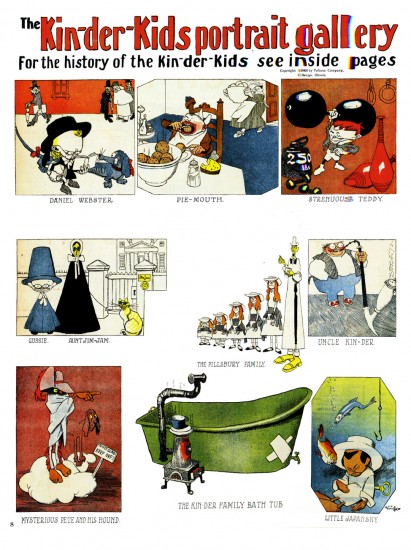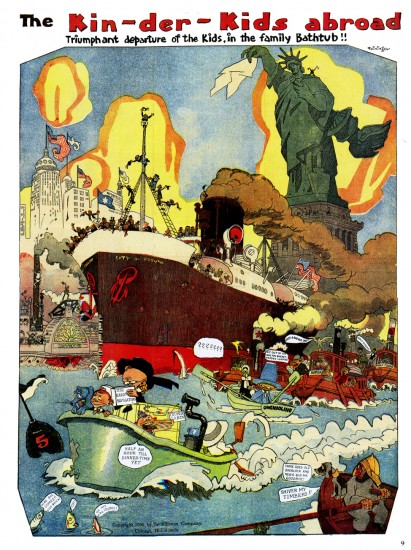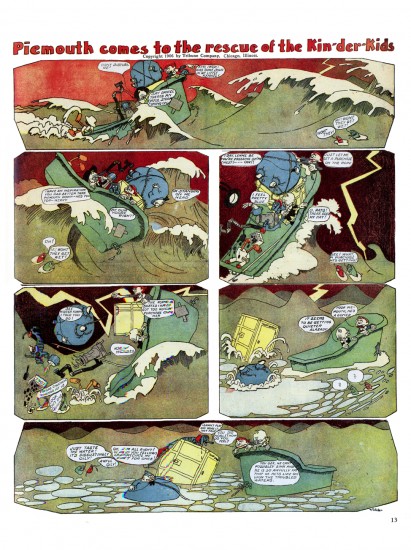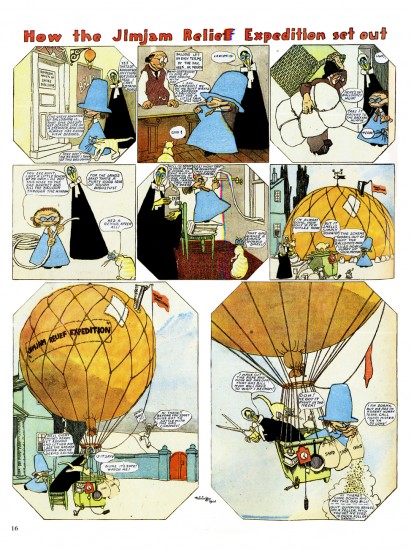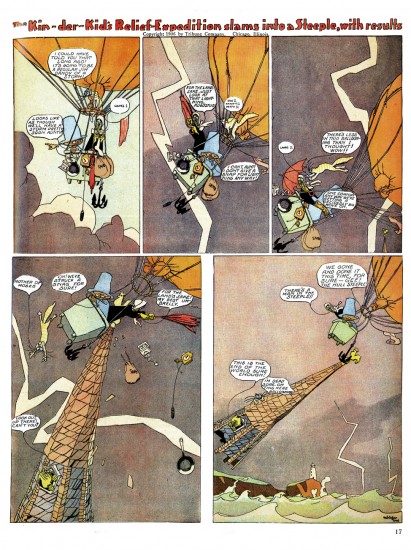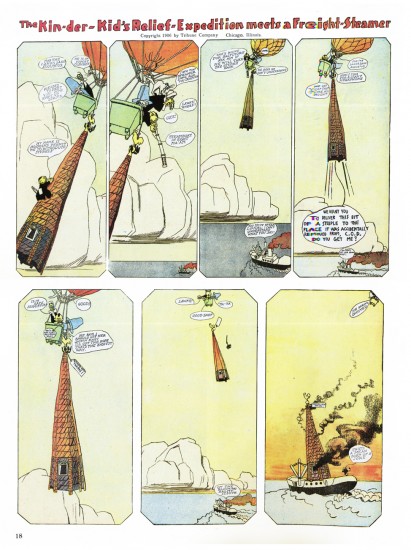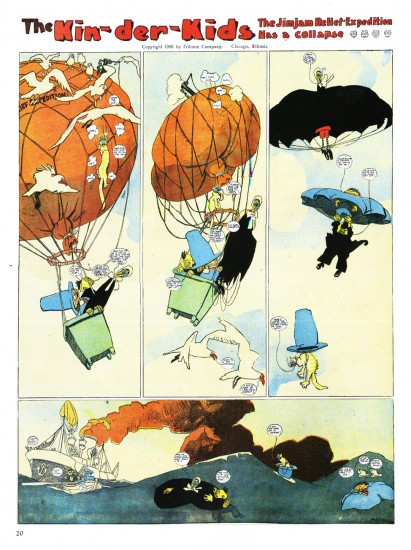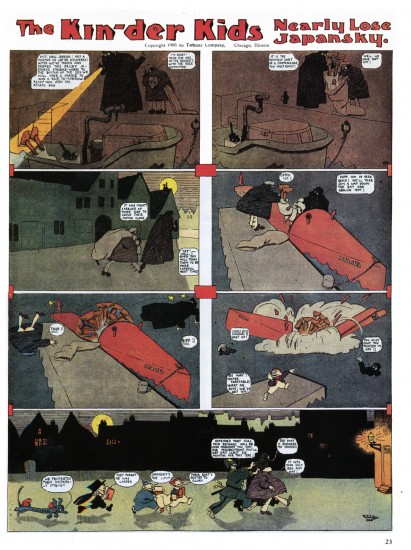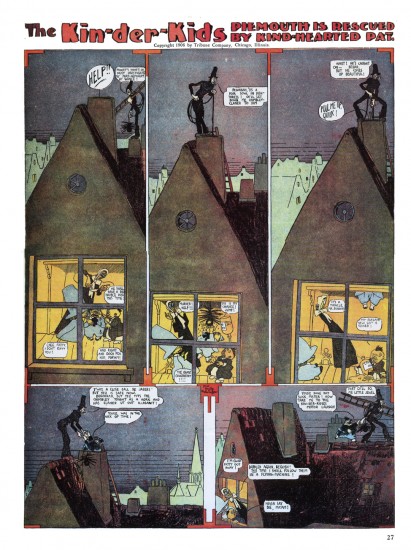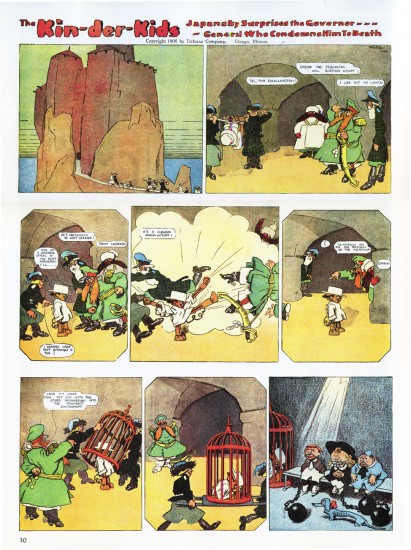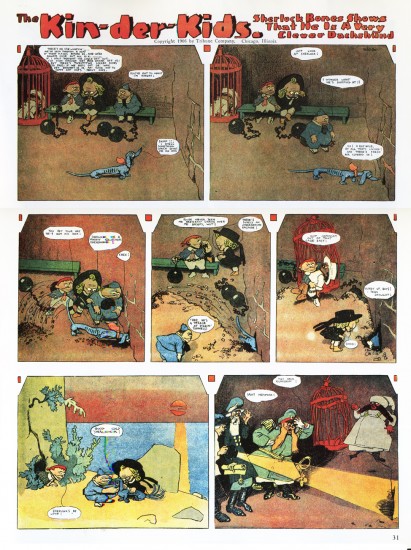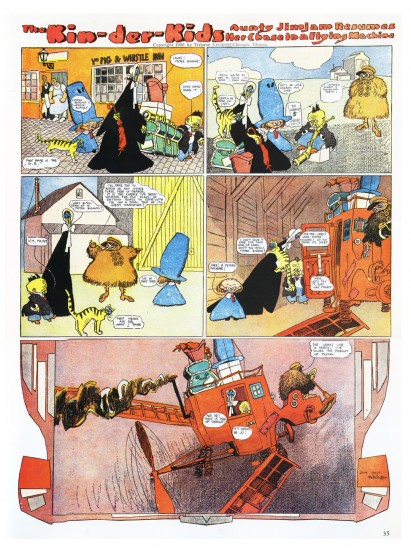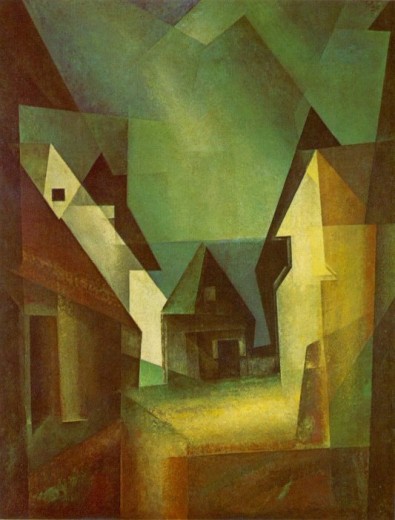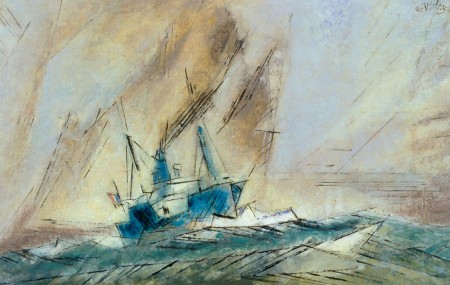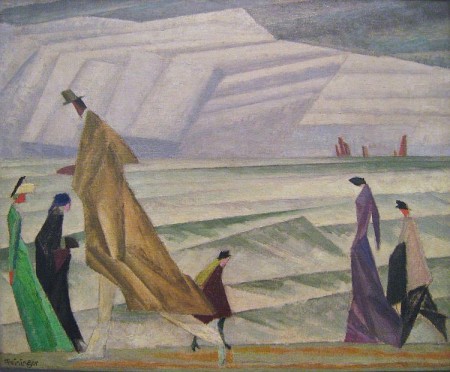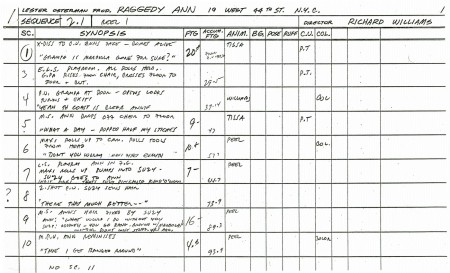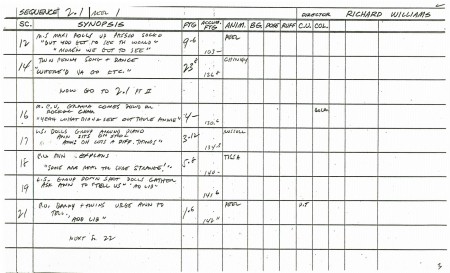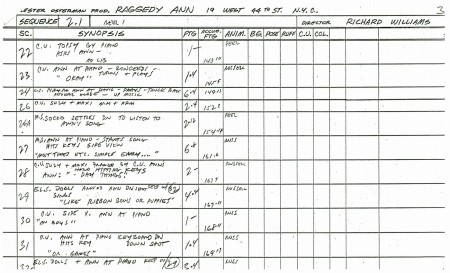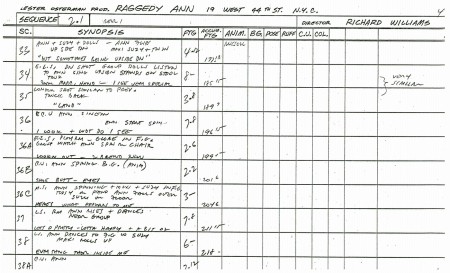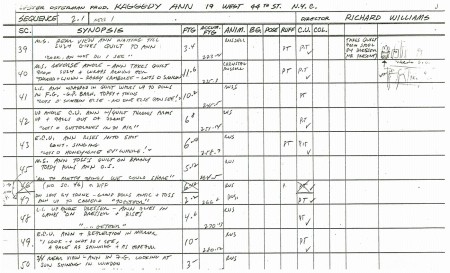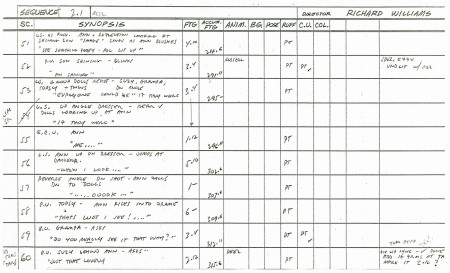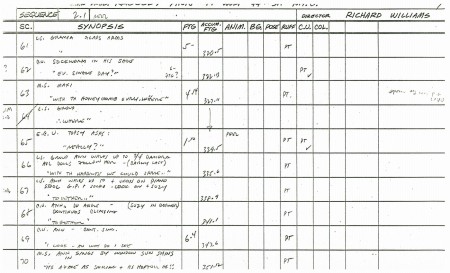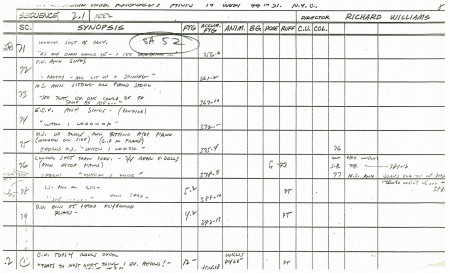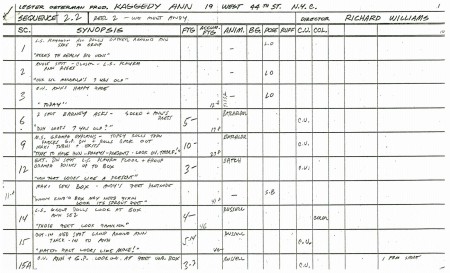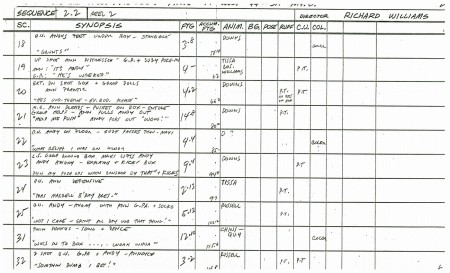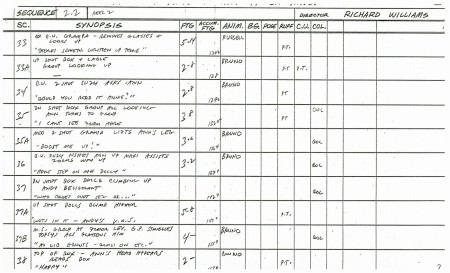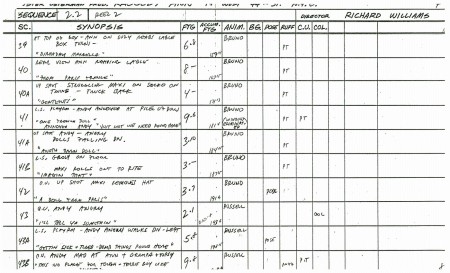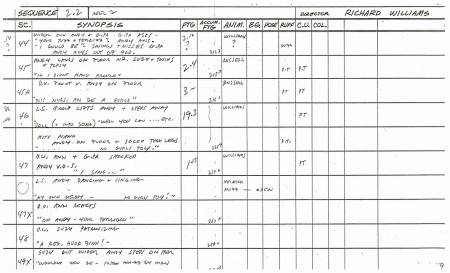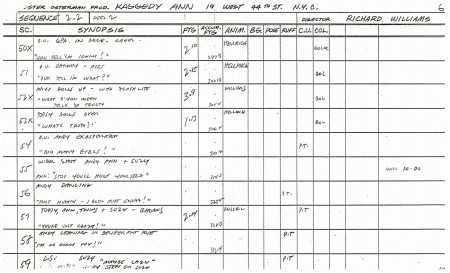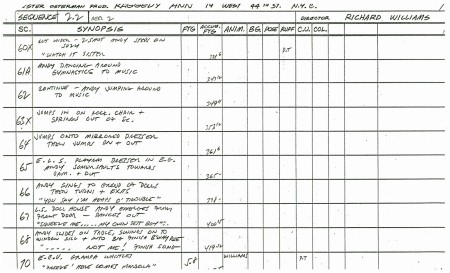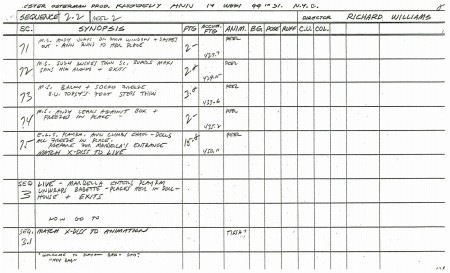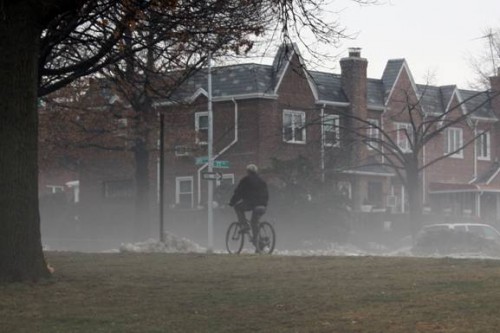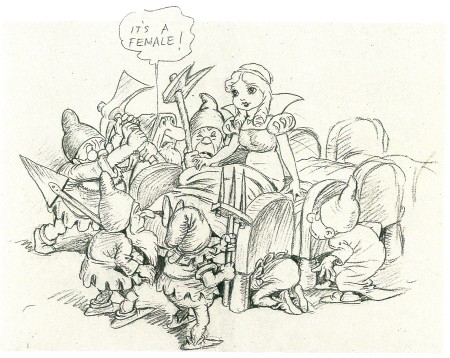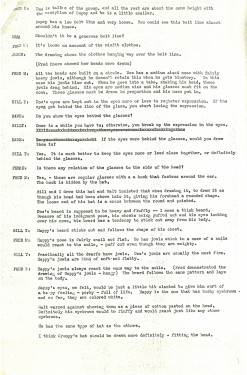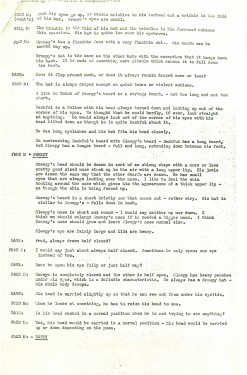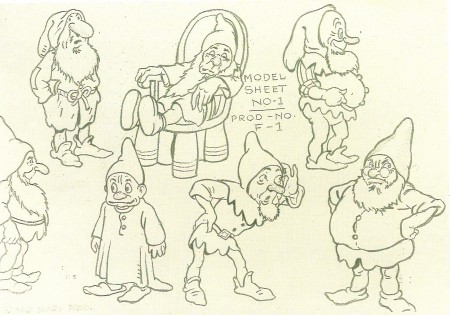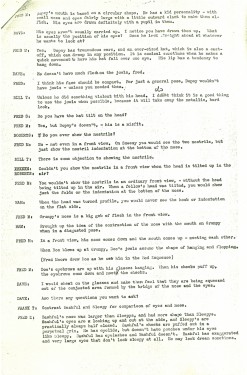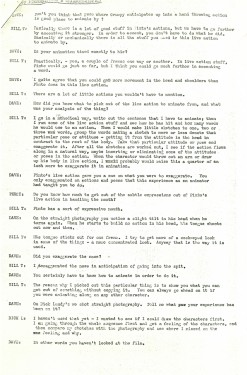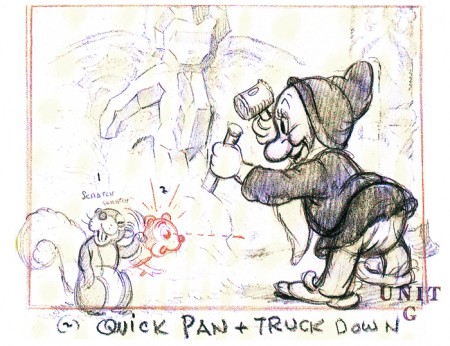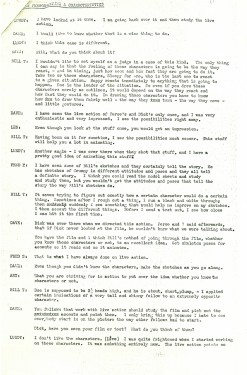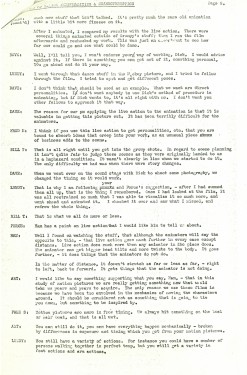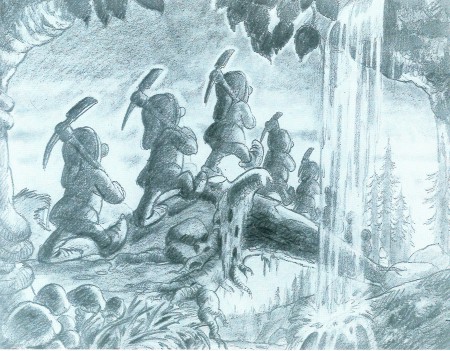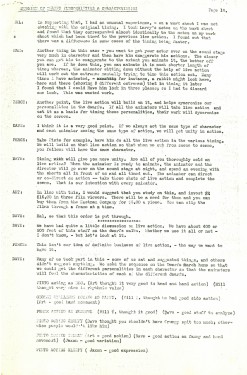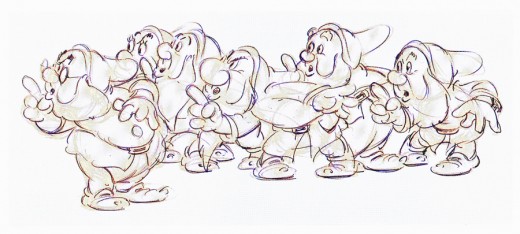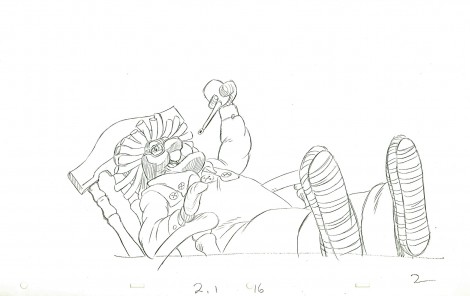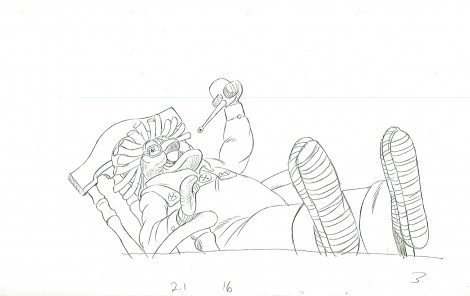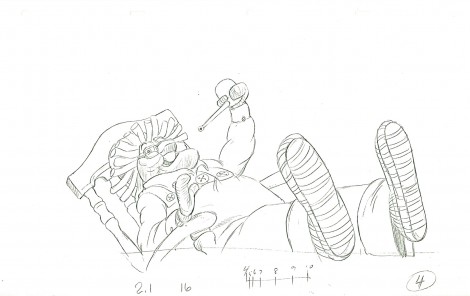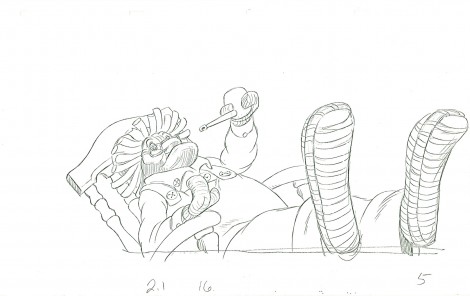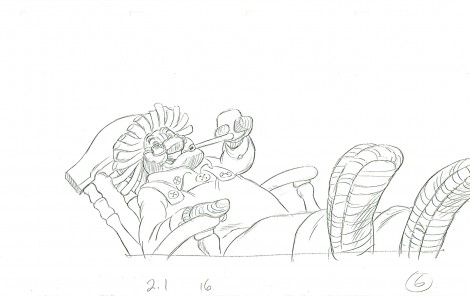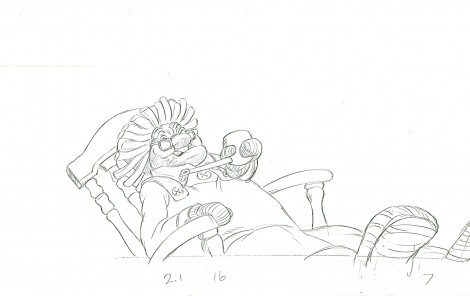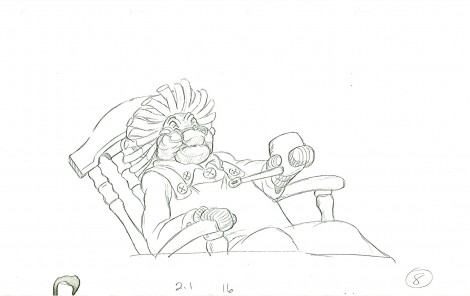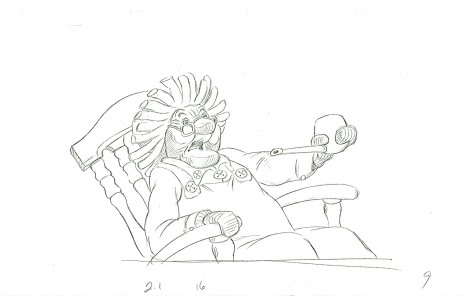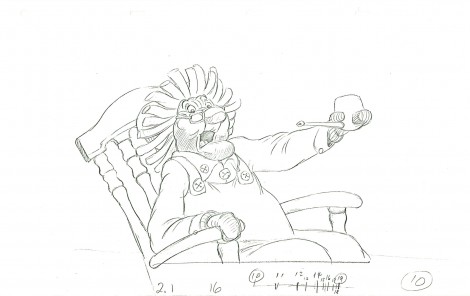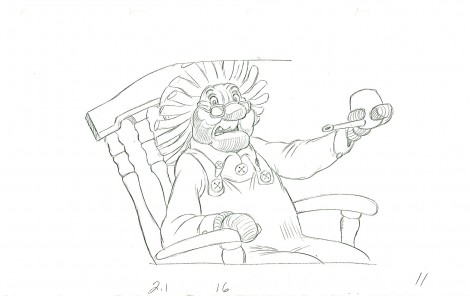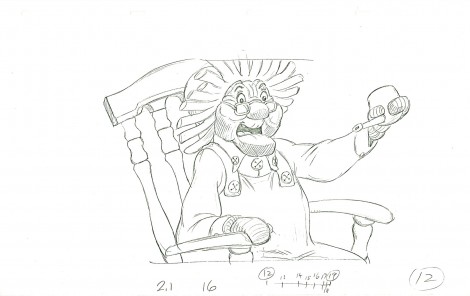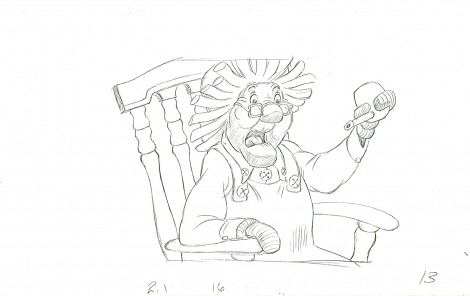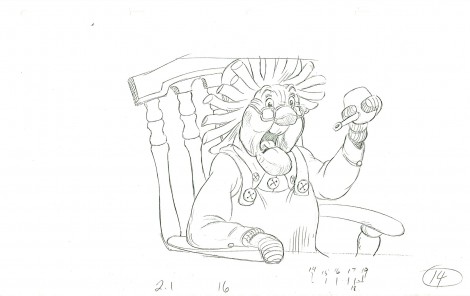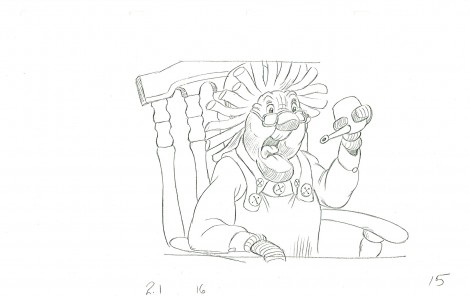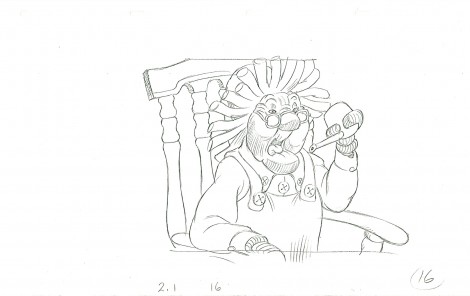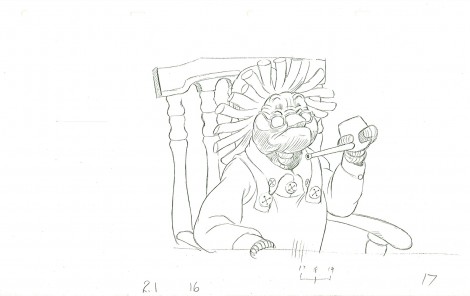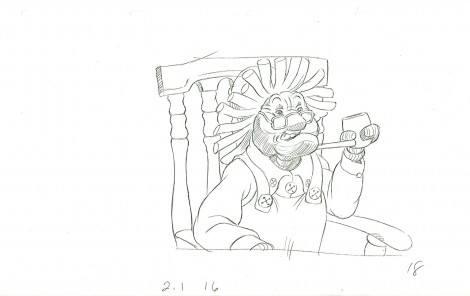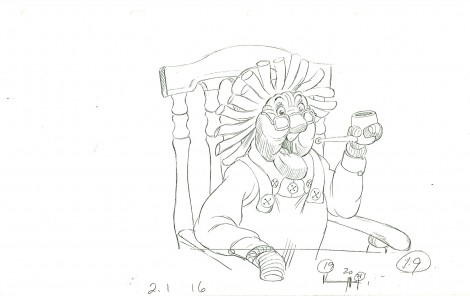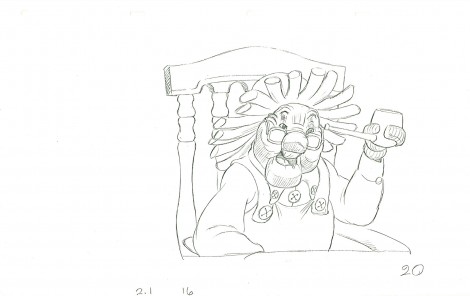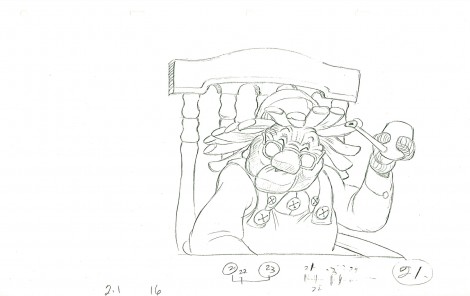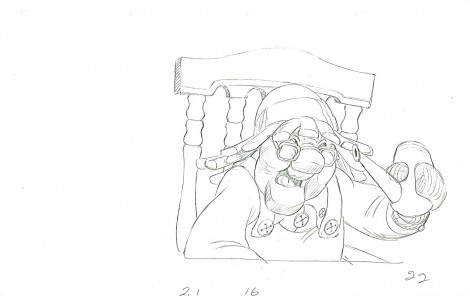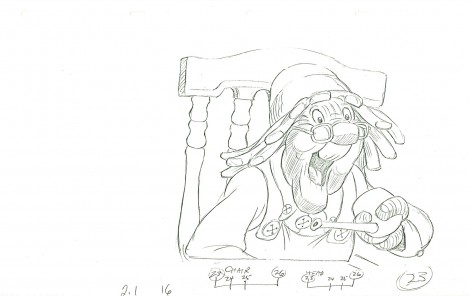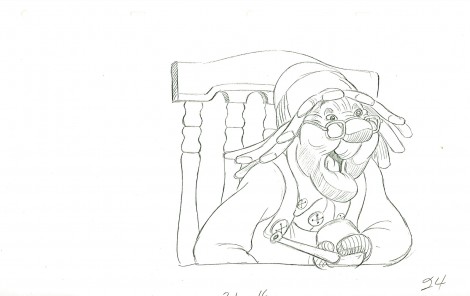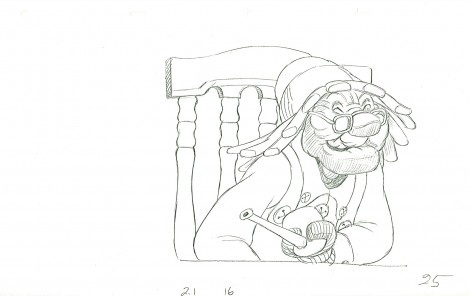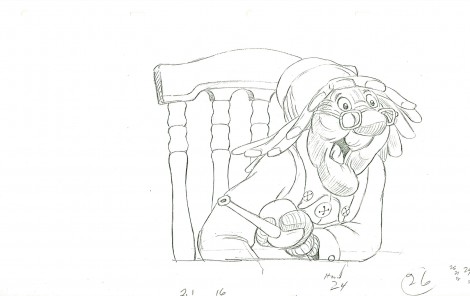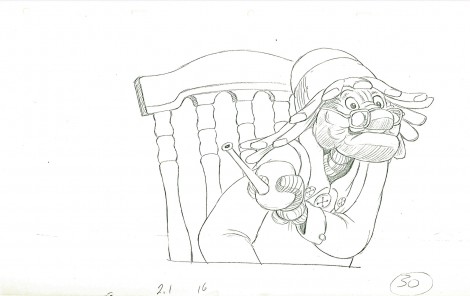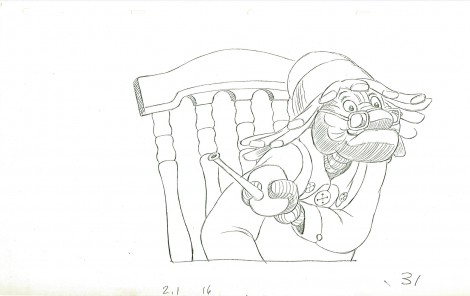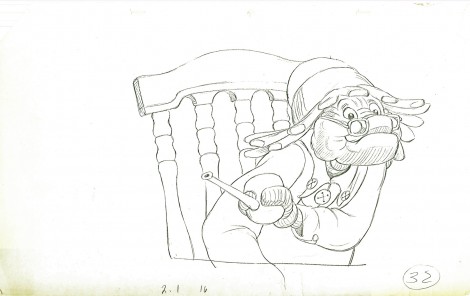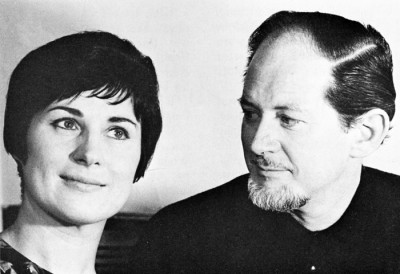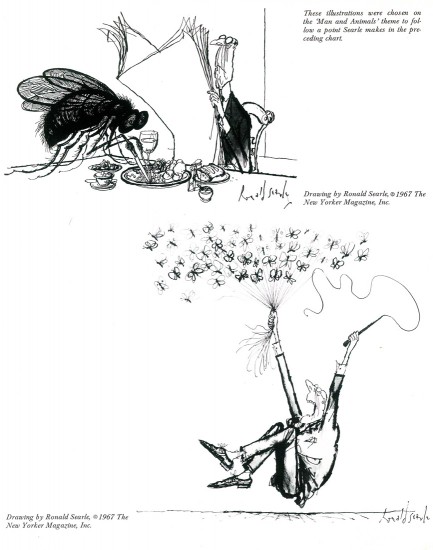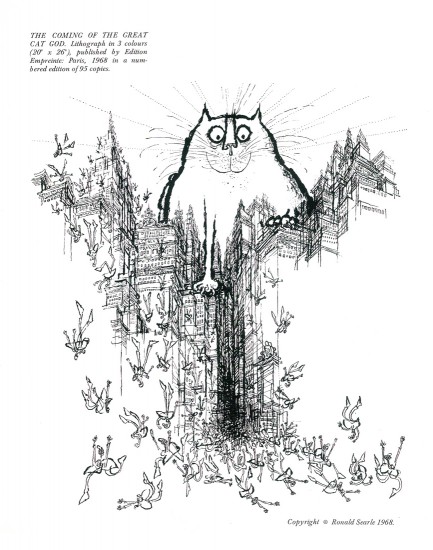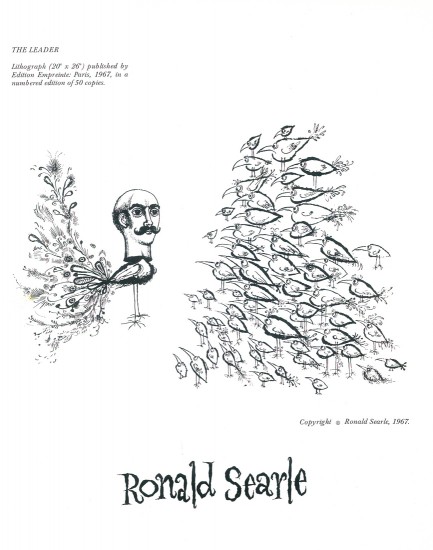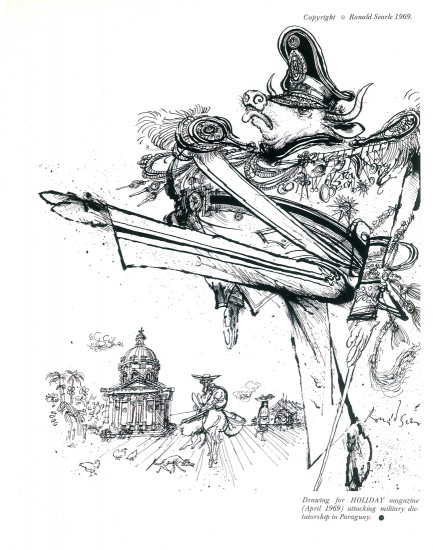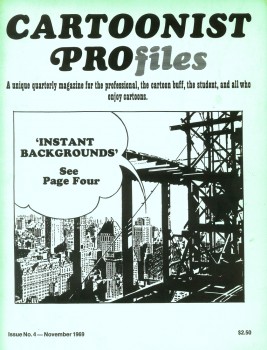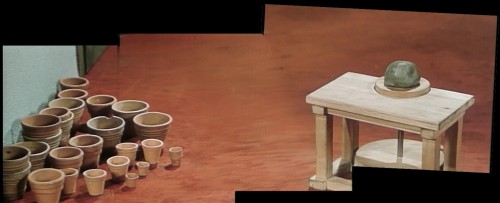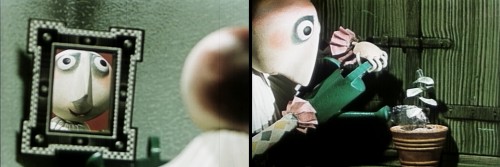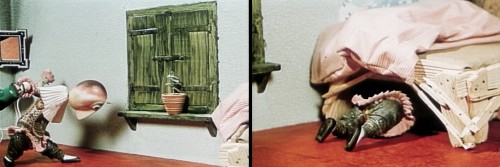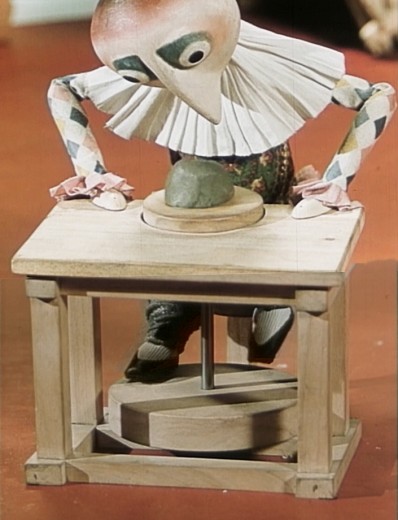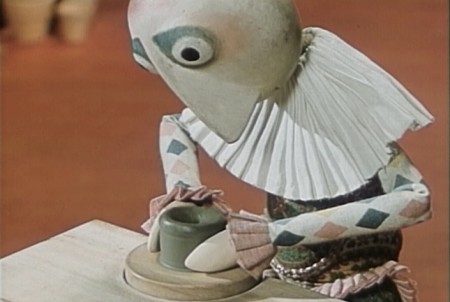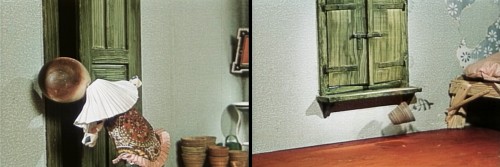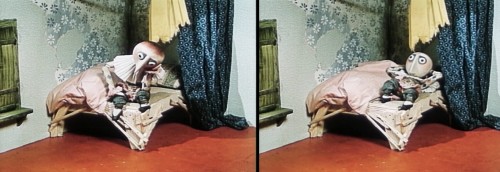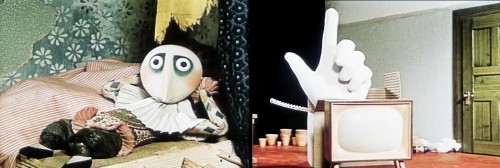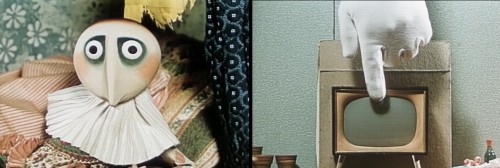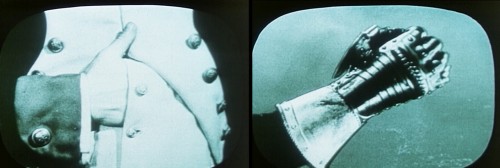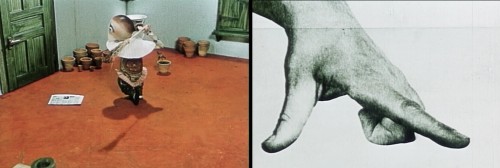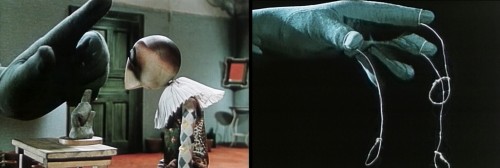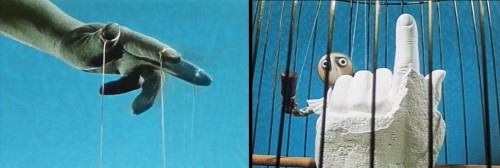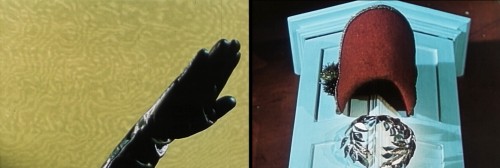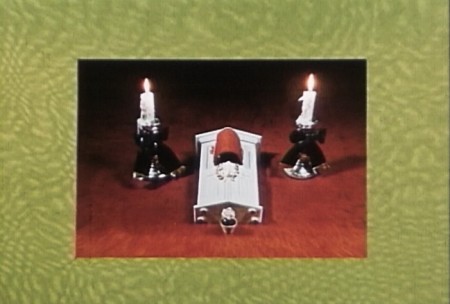Monthly ArchiveJanuary 2011
Art Art &Bill Peckmann &Comic Art 11 Jan 2011 08:34 am
Feininger 1 – The Kin-Der-Kids
- Lyonel Feininger was most famously known for his artwork done in Germany as part of the German Expressionist movement. Interestingly enough, he didn’t start his serious art until the age of 36. Born in the United States in 1871, he created two early comic strips which were commissioned by the Chicago Tribune in 1906. They were trying to compete with the best strips of the day and chose to look to their own German-American community. The Kin-der-Kids and Wee Willie Winkie’s World. Both strips stand up with the best of Winsor McCay’s comic strips and, in some ways, is even more graphically daring than McCay.
Bill Peckmann has loaned me an excellent book collecting the strips of Feininger. In this first post, I’ve selected some samples of The Kin-der-Kids strip.
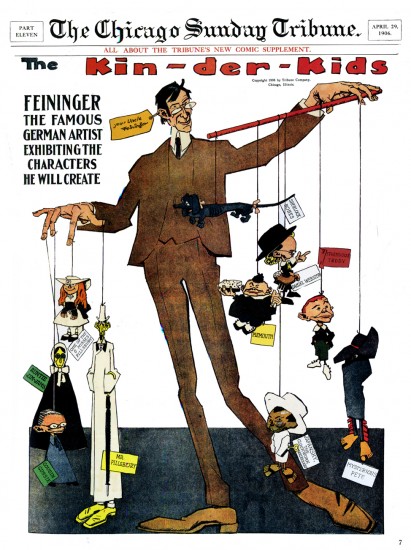 1
1The paper started the strip off with a big bang.
To give an idea of Feininger’s art after the comic strips, I’ve culled these few images of his paintings from various sites.
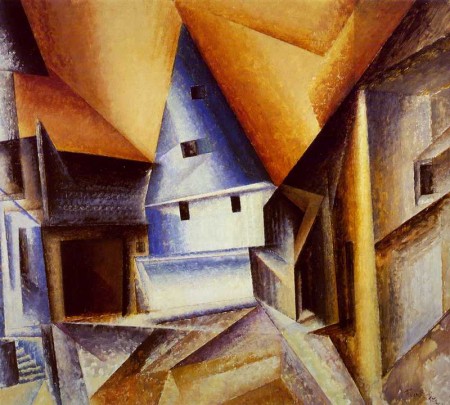 1
1Oil on canvas
Layout & Design &Richard Williams 10 Jan 2011 09:17 am
Raggedy Drafts – 1 / seq. 2
- I received a request to post the drafts to Raggedy Ann & Andy. I’ll post all that I have. These come from a second and more complete group. The format changed from the traditional Disney formula (8½ x 14 vertical) to this (8½ x 14 horizontal). There’s much more info here.
However, let’s start with a great Corny Cole drawing of the Greedy, a breathing, living taffy pit. Done on 16×17 drawing paper, punched, with a BIC pen.
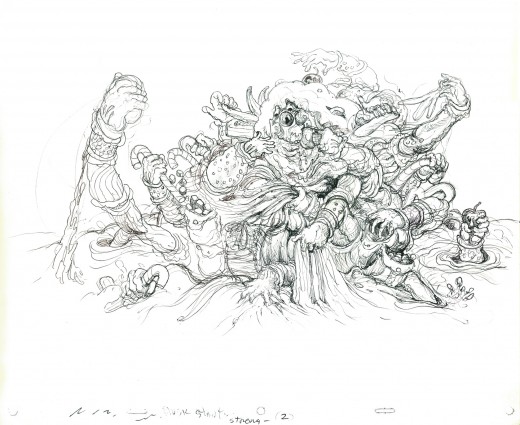
The Drafts – seq. 2.1 The dolls come to life
seq. 2.2 – Big news
Photos &Steve Fisher 09 Jan 2011 08:48 am
Foggy Day in NY town
- We’ve seen lots of weather in the past two weeks. A blizzard on the day after Christmas bottled up New York and all its garbage collection. Then there were several days of spritzing rain and warm weather. Everything got wet and black. Then another snow storm that didn’t really stick, and we’re expecting more on Tuesday.
Amid all this, Steve Fisher caught the town off guard when fog rolled in. Here are a bunch of his photos making NY feel like London in the 60s.
 1
1(Click any image to enlarge.)
Animation &Animation Artifacts &Commentary &Disney 08 Jan 2011 08:45 am
Oscar shorts & Poe & Plane Crazy
 - Today’s the day for Oscar voting narrowing the 10 films of the short list down to a reasonable five nominees. The Academy will screen the films for us, and after each one we vote a numerical score. The top five get in.
- Today’s the day for Oscar voting narrowing the 10 films of the short list down to a reasonable five nominees. The Academy will screen the films for us, and after each one we vote a numerical score. The top five get in.
The two coasts, NY & LA have very different tastes, so I rarely expect that the films I like will be liked by others, nevermind the West Coast people – who are more studio oriented, thus favoring what I consider some dreadful films. I can only hope they won’t make it to the finals.
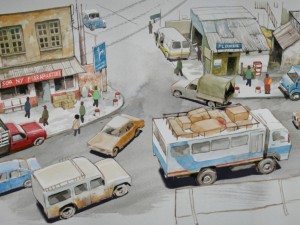 Part of the fun of voting is the get-together the people in NY prepare for us. Patrick Harrison and John Fahr put together a day that makes it as easy as possible for us. The lunch they serve is always the high point of the day, and we animators get to mingle and catch up on our disparate career waves. It’s just fun, even if it is a day of sitting on the butt riding out some bad movies. There are also some really good ones, too.
Part of the fun of voting is the get-together the people in NY prepare for us. Patrick Harrison and John Fahr put together a day that makes it as easy as possible for us. The lunch they serve is always the high point of the day, and we animators get to mingle and catch up on our disparate career waves. It’s just fun, even if it is a day of sitting on the butt riding out some bad movies. There are also some really good ones, too.
If you want to see what films are in the shortlist, Cartoon Brew did a nice little announcement of the titles back in November, with stills and links etc.
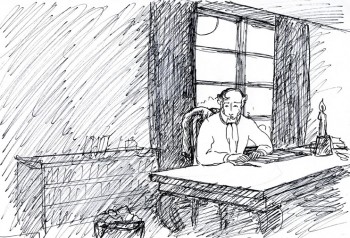 - Tissa David turned 90 this past week. If, as I expect, the money for my feature POE comest through in the next month, I suspect (but can’t prove it), Tissa will be the oldest animator working regularly on a film. At least, I will be privileged to have her input on my film. It’s all very exciting for me. I intend to ask Ed Smith to get involved, as well. Perhaps he’s the same age as Tissa?
- Tissa David turned 90 this past week. If, as I expect, the money for my feature POE comest through in the next month, I suspect (but can’t prove it), Tissa will be the oldest animator working regularly on a film. At least, I will be privileged to have her input on my film. It’s all very exciting for me. I intend to ask Ed Smith to get involved, as well. Perhaps he’s the same age as Tissa?
- To leave off with something nice let me post this drawing I have from PLANE CRAZY. That’s a short that deserved an Oscar – but, alas, ikt came before the award existed. I bought this drawing from John Bruno, who sold such material at the time, so many years ago. He wanted $50 for it in 1977, and I couldn’t give him the money fast enough.
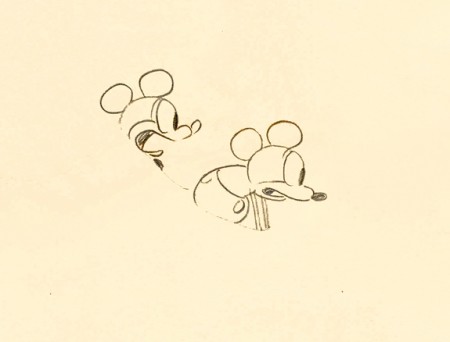
(Click to enlarge to see the full animation page, holes and all.)
Animation &Disney &Story & Storyboards 07 Jan 2011 09:03 am
Snow White Story Meeting
- Here are the steno notes of a story meeting on Snow White‘s dwarves. I’m sure this has been printed somewhere or posted on someone else’s blog, but I don’I kniow where. So I’ve decided to post it “again” (in case someone else has it out there). I’ve added some drawings of the dwarves to color the post.
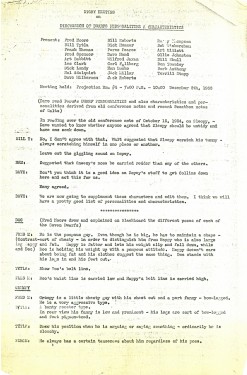 1
1 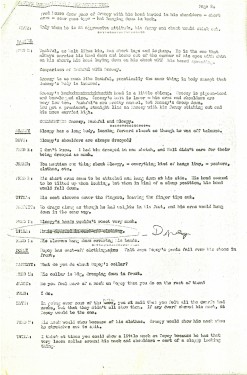 2
2
Animation &Models &Richard Williams 06 Jan 2011 08:42 am
Gramps
- I have the CU drawings done by Richard Williams for a small scene from Raggedy Ann & Andy. I believe the original animation was done by Spencer Peel, though I’m not sure. It may have been Gerry Chiniquy.
For the first half of the film, Dick spent much of the film holed up while assisting and inbetweening many of the animators at the film’s start. In doing this, he was also able to rework and retime the animation and, thus, have control over it all.
The problem was that the director has bigger things to do that affect the big picture.
This scene, beautifully cleaned up, is typical of these scenes. And yet, as far as I can see this was eliminated from the final film. I don’t have time to check the actual film, but the drafts indicate that scene 2.1 / 16 was taken out of the movie. I’ll look at the film just to make sure, but it looks pretty obvious to me.
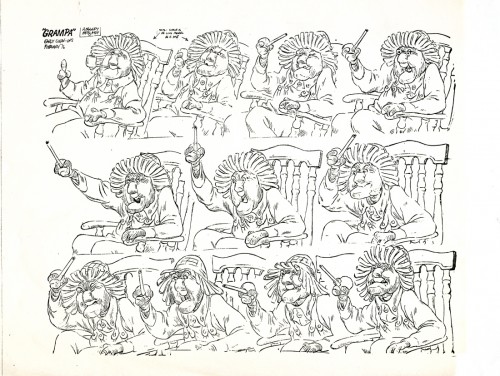
This is a model sheet taken from a similar scene in Raggedy Ann.
It’s obvious that his POV has shifted from left to right, and that may be
the reason for eliminating the scene pictured below.
The scene started out with 32 drawings, but it seems that Dick eliminated three of them (27-29) to hit an accent a bit harder than was done in the original animation.
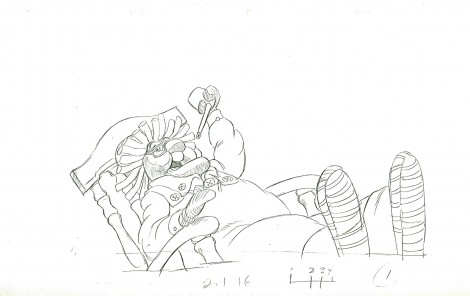 1
1
________________________
Here’s a QT of the cycle with a mix of one’s and two’s.
Articles on Animation &Illustration 05 Jan 2011 08:30 am
Ronald Searle in Cartoonist Profiles
- Here is an article about Ronald Searle pulled from a copy of Cartoonist Profiles issue #4. It dates back to November 1969.
Writes from
FRANCE
The following article, and the accompanying ‘ideas chart’, were written for CARTOONIST PROfiles by RONALD SEARLE, the noted European cartoonist who makes his headquarters in Paris. He created St. Trin-ian’s, which has become a part of English folklore, has illustrated more than 40 books in the past 23 years, has designed sets and costumes for films, made his own cartoon film John Gilpin’, and constantly does work for American, French and German magazines. One of his publishers describes him as Europe’s most accomplished cartoonist — a macabre black humourist, a lynx-eyed reporter, a gagman of genius, a draughtsman of the stammering line and the delirious arabesque that inimitably characterises his world.
My childhood was unremarkable apart from the fact that I was born and brought up in one of the most beautiful and ancient university towns in England. I drew before I could write legibly (I am left-handed), and I swapped comics in the school yard; no doubt gathering supplementary festering sores in the process. The dog-eared sheets which passed from filthy hand to filthy hand, were hardly recognizable as copies of “Comic Cuts”, “Film Fun” and “Chips ” — the most desirable titles at that time. The more pictures there were to a page and the less text, the happier I was, like all lazy-minded kids. My imagination was almost entirely visual and only faintly literary. However, my great love was books. I devoured everything in our town library, beginning with the infant shelves and graduating at the age of twelve to the adult library. My thirst was insatiable. I frequently took out five books in a day; making my way through A-B: “British Butterflies in Colour”(c. 1894)to Y-Z: “Zjululand, The journal of my encounters in” (c. 1901, I guess). By the time I was 13 I wanted my own library and I began to haunt the secondhand bookstalls and barrows in Cambridge. I earned, begged, and scraped together every penny I could and within five years I had accumulated some 500 volumes for a few pennies apiece. At the outset of my buying, one Saturday, I tumbled onto two or three volumes about caricature, at 6d. each. One of these volumes was Spielmann’s “History of Punch”. I had already decided I would be either an artist or an archeologist and with juvenile confidence I now added the intention of being a “Punch “cartoonist.
That Autumn I enrolled for evening classes in the Cambridge Art School. This had caused some argument between my mother and father for the fee was 7s.6d. a term (about $1.50 then), and we could not afford it. But the money was scraped together somehow. I can guess now that my mother probably put a thicker piece of cardboard in her shoe.
I was obsessed with drawing, and scratched away incessantly. I scrambled through the day at school and my homework afterwards and then rushed off at six in the evening, for three hours of art. By the time I was fourteen I had graduated from the plaster Discobolos into the life class, and painfully shaded my way through several years of floppy-breasted nudes with blue toes and purple legs. It was difficult to keep the fen winds, which blew across the North Sea from Siberia, out of our life-room. Side by side with my art-school work I scribbled comic drawings. The next year, when I was 15, the cartoonist of the local paper left for London and higher things. I stuck a cartoon through the letterbox of the “Cambridge Daily News”, utterly confident that the editor would take it, and that this would solve an important economic problem for me. He did take the cartoon and asked me for more at 10s.6d. a week (about $2.00 then). This represented all the drawing materials I needed, a bit for the family and something over for me.
I continued with those weekly cartoons from 1935 until the war, almost without a break. They were dreadful, but they taught me how to draw for reproduction.
By 1938 the local council had awarded me a full-time art scholarship, and I sweated away for over a year, as a “real, full-time artist”. Lautrec was more precocious, but he was never as happy as I was then. By the time I went into the army, at the outbreak of war in 1939, I had completely saturated myself in anatomy, perspective, history of costume, architecture, life drawing, and all subjects required for passing the Min. of Ed. Drawing Diploma. I missed failure by 2%, but achieved the solid Bolshi-Academic grounding characteristic of Cambridge in the ’30′s.
Also in 1939, I found on a secondhand bookstall, a small monograph by Marcel Ray on the work of George Grosz. It cost me 2s. and changed my artistic direction. I had already established a pedestal for Picasso as the foremost of my living heroes, and I was still grinding my teeth at being unable to raise the $35.00 he was asking then for a pen drawing at a local gallery. Forain I marvelled over, despite his loaded anti-semi-tism, and he had joined the line with Gillray, Rowlandson and Cruikshank, as my self-appointed guardian angels. Daumier’s work was difficult to find, and I had not been able to form an opinion of him then. Goya, however, was one of my gods, and I still day-dream that one day the Prado will drop me a note during a period of stocktaking, to say that they wonder whether I might be interested in accepting a couple of drawings of which they have duplicates.
If anyone influenced me in my work it was on the basis of draughtsmanship, rather than painting. I saw in line then, as I still mainly do now. Above all I admired “Roly’ Rowlandson, with his wit, genius, ability to handle line, ability to range from the broadest and most clownish grotesque to a cunning subversive charm. I cannot say that I have ever consciously had the desire to copy anybody. But if I have been influenced, it is by Rowlandson. And Grosz. Although I had known little about Grosz until I got the Marcel Ray book. I had seen the occasional Munchen album from the ’20′s, and had heard of his flight to America. From time to time I had come across a drawing of his in “Esquire”. But now he fitted into place for me. Grosz exposed the rotting military mind; the filth of war and the stench that lingered after it — and, how he could draw! With this book of his I headed off for my seven years as a soldier.
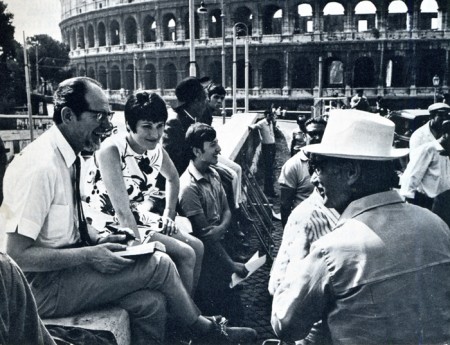
Searle and Monica on location in Rome last year, during the
filming of Paramount’s “Those Daring Young Men in their Jaunty Jalopies”,
for which he designed the animated credits sequence. Searle had previously
designed a similar sequence for the 20th Century Fox film “Those
Magnificent Men in Their Flying Machines”. Working with Searle was
the lively young English group “Trick-film”, who made the very successful
“Yellow Submarine”, and with whom Searle is now associated in the
formation of an animation workshop in London.
During those seven years I never stopped drawing. I was a conventional art-student when I went into the army. Before 1939 I had rarely left the town in which I was born. When I came out of a Japanese prison in 1945, after four rough years, I had enough experience of humanity and inhumanity to provide me with a measuring-stick for a considerable part of my life. I also had the facility of seven years of practical application with my drawing. I had documented almost every move I had made, from my first miserable night in the army to the other side of the world and back.
I had been isolated from the world for almost four years; but had also developed in that isolation.
It was then that I was faced with earning my living. I had nothing but fantasies in my head, and a small army pension between me and the post-war wolves at the door while I was getting rehabilitated and thinking about long-term plans for the future. It seemed to me that the only fast and easy way of keeping myself fed was to sell cartoons. So I sold cartoons. This I rapidly discovered needed no particular ability apart from being able to communicate a personal way of looking at things; and apart from having enough nose to smell out the flavour of what was going on and putting it to use. Coming as I did from an atmosphere of stinking cells, wasted bodies and grim humour, my humour was ‘Black’. But so was the post-war climate of rationed England, and my work found a ready market there. I cannot say that I ever thought of cartooning as an ultimate career. All I knew was that I wanted to eat and that I wanted to draw, and this was one way of being able to get some of the disgust I felt for human behavior into print (comically wrapped-up for public consumption). At that point I became a part-time cartoonist. I still am.
Drawing for me has never been a case of therapy because I was shy, or not outstanding in physical activities, or anything else. It was a compulsion. I carried a sketchbook day and night, because I could not stop drawing. To sell a sketch was a pleasure, because it meant a little less economic worry and more freedom to explore. But if I had not sold, I still would not have stopped.
To me line is something which one can explore endlessly, and which keeps me in a constant feeling of excitement and adventure. I know I shall never live long enough to say and do all I want in line. I can only hope to get up each day, bursting to push the exploration a little further. But line is useless if one has nothing to say with it. The artist must be driven with the desire to express something, and use any device to achieve it. He must be perverse. Everybody will want to mould him to their pattern. But in the end he has to satisfy himself — or spend his life trying to please other people.
If satisfaction with one’s work creeps in, the time has come to give up and take to prostitution. A sure sign that there is still hope is when one is miserable at not having met one’s own demands.
The hand is feeble and the artist has still to express with exactitude what his brain conjures up.
Some day it may be possible
The apple tree on the opposite page was compiled out of curiosity in an attempt to answer the editor’s question: “What routine do you go through to dredge up ideas?”.
It covers the period 1966-1969, and covers the area of ideas only, as opposed to other work made alongside: Book illustration, cinema animation and so on. In 1966, I set out with three main themes as subjects: Cats, Birds, and People. Subsidiary themes, such as Pigs, and Snails crept in soon after. The first four subjects led me to three books, and the Snails led me to a fourth. Lithographs, New Yorker covers and cartoons, and a series of exhibitions developed alongside. As is apparent from the confusion above, I do not attempt to force ideas, but rather to let them drift inconsequentially — and frequently into a dead end. In this case I started out with Cats in 1966, and arrived at Toulouse-Lautrec in 1969. Some drift! I work with no fixed market in mind. Some ideas may best be expressed in lithography, others as large water-colours, others in pen. When they have been sufficiently developed I start worrying about placing them. The outcome of the three years in question was: some 30 large lithographs; 12 New Yorker cartoons and four covers; four books: “Searle’s Cats” (1966/67), “The Square Egg” (1967/68), “Hello – where did all the people go?” (1968/69), and “Hommage to Toulouse-Lautrec” (1969). In addition, 19 exhibitions in galleries in France, Germany, Austria, Sweden, Switzerland and England were arranged for 1966-1970. Here, either the originals or series of lithographs are for sale. Exhibitions are aided by the fact that, to publish books of this sort at an economic price, they need to be captionless and published in simultaneous co-production in England, France, Germany and America. Most of the material in these books has not been previously published — apart from the occasional sale of serial rights. As a working method it is not particularly scientific, or organized. The only factor I watch is: that whatever I do is thought of as an international idea — that it will have equal appeal in any of half-a-dozen countries. Or be equally rejected.
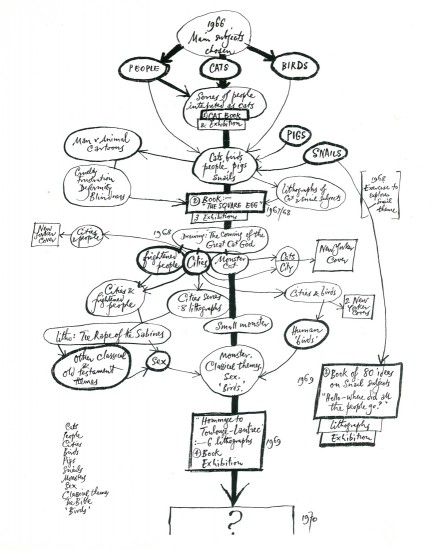 1
1
Animation &Richard Williams &Title sequences 04 Jan 2011 08:16 am
Jaffe & Turkey & Titles & Tulip
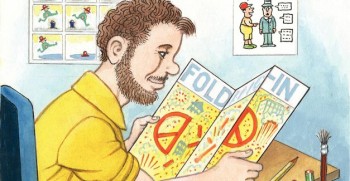 - The Huffington Post currently features an article about and an interview with MAD Magazine cartoonist / writer, Al Jaffee.
- The Huffington Post currently features an article about and an interview with MAD Magazine cartoonist / writer, Al Jaffee.
Jaffee has long been a mainstay at the magazine, and he is something of an idol to many up and coming cartoonists (as well as to many who up and came.)
It’s an entertaining and short read which you’ll enjoy.
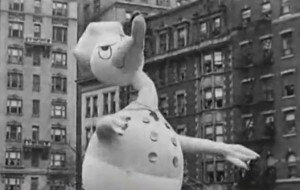 - Circulating recently is a YouTube video of the 1935 Macy’s Thanksgiving Day parade with a prime feature being the balloons.
- Circulating recently is a YouTube video of the 1935 Macy’s Thanksgiving Day parade with a prime feature being the balloons.
Particularly entertaining is the wild and wacky Donald Duck (the 1935 Donald) completely out of control. I also enjoyed seeing how they dealt with the elevated train station interfering with the movement of the balloons. This isn’t a problem today.
It’s a short, fun video, if you haven’t seen it.
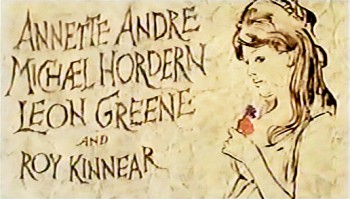 - Mark Mayerson calls appropriate attention to a site which features stills of many film titles through history. Movie Title Stills. It’s an entertaining site, indeed, and the only one to really go back into early film history.
- Mark Mayerson calls appropriate attention to a site which features stills of many film titles through history. Movie Title Stills. It’s an entertaining site, indeed, and the only one to really go back into early film history.
There are a number of sites out there which feature and celebrate movie titles.
Forget the Movie and Watch the Titles is one which breaks them down into categories. There are 147 title sequences listed and 49 of them are animated. Most of them are newer sequences like Kung Fu Panda or The Pink Panther 2 (the Steve Martin one).
Art of the Title also has a large number of title seqeunces including some older titles. Many of the Saul Bass titles can be found here, as well as one of my favorites, To Kill a Mockingbird. This site will first take you to frame grabs of the titles but then you can click to download the film sequence. They also include several interviews with a number of designers.
All of Saul Bass’ work is featured on the site Not Coming to a Theater Near You. Here there are predominantly still images from the credits, but a lot of them. If you’re a Saul Bass freak, this is a place to visit. Many of these same titles can be found elsewhere on the net. At Signals vs Noise, for example, you can watch videos of 11 of them.
Richard Williams’ title sequences can’t be found on any of the above sites, but if you go to YouTube, TheThiefArchives has uploaded a number of them (as well as quite a bit more of Dick’s work.)
The first site of this sort that I found was a French one, Generique-Cinema. I found them when I learned that they had an entire page for me listing most of my film titles:
1981 – Prince of the City (Sidney Lumet)
1982 – Deathtrap (Sidney Lumet)
1984 – Garbo Talks (Sidney Lumet)
1985 – Desperately Seeking Susan (Susan Seidelman)
1987 – Making Mr Right (Susan Seidelman)
1988 – Running on empty (Sidney Lumet)
1989 – Family Business (Sidney Lumet)
Finding this site, way back when, was a treat.
Paul and Sandra Fierlinger‘s film, My Dog Tulip, returns to the Film Forum for nine days only. January 5th through 13th. It’s on a double bill with the documentary, The Kings of Pastry, a DA Pennebaker and Chris Hegedus film. A double bill, two films for the price of one.
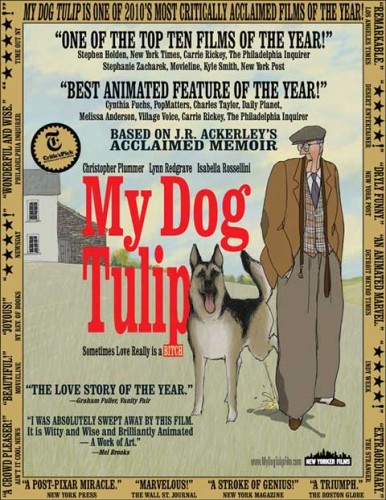
Animation &Frame Grabs &Trnka 03 Jan 2011 08:20 am
The Hand
- I decided this week, I wouldn’t go to a Disney cartoon to give a frame grab display. Instead, I’ve chosen to showcase images from Jiri Trnka‘s brilliant film, THE HAND. This is an anti-totalitarian film done from behind the Iron Curtain when it was forbidden for him to do so. There, presumably, were consequences (though I don’t know any specifics.)
 1
1The film’s title plays in four different languages.
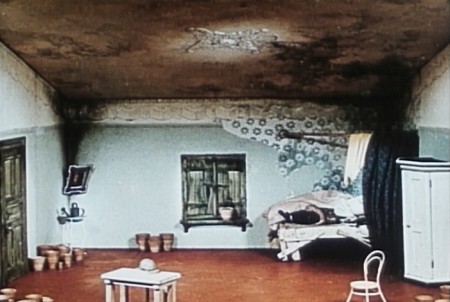 2
2
We see inside the sculpter’s house. LS to . . .
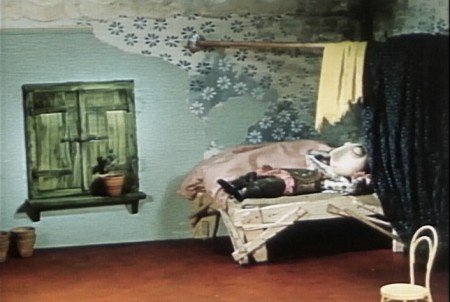 3
3
. . . closer shot of him in bed.
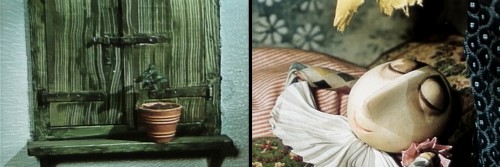 5
5
One plant in a pot in the window.
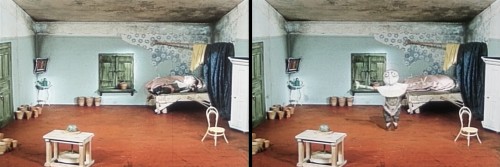 6
6
He gets up, exercises and . . .
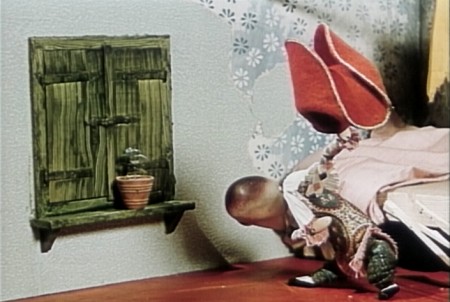 9
9
He says a formal good morning to his plant.
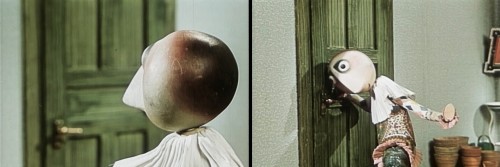 12
12
A loud knock – is it the door?
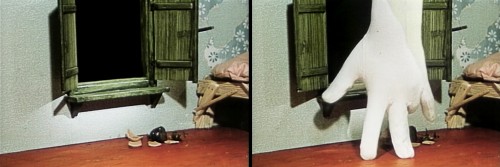 14
14
A giant hand bursts through the window knocking the plant to the ground.
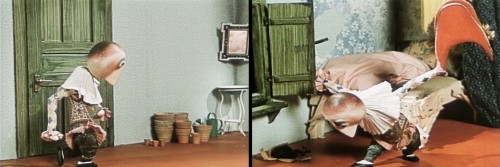 15
15
The potter goes through the same formality of bowing, good morning, to the hand.
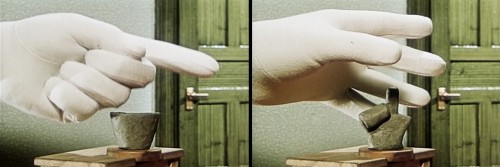 16
16
The hand tells the potter he wants a commissioned statue of himself.
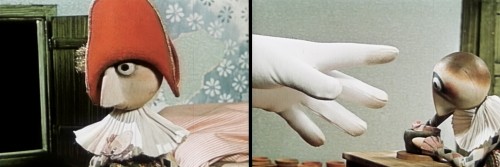 17
17
The potter says “NO” many times.
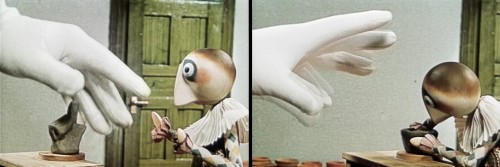 18
18
Even rushing to get back to creating a new pot.
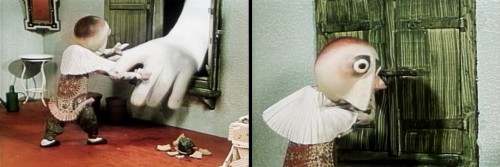 19
19
Then he pushes the hand out of the shop . . .
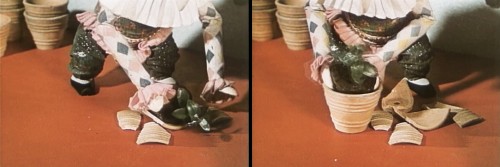 20
20
. . . and he attends to the damaged plant.
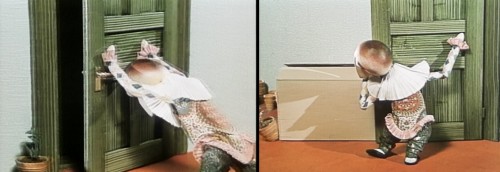 21
21
The hand is back again and the potter tries to keep him out.
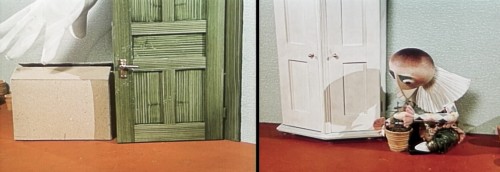 22
22
The hand pushes in a cardboard box.
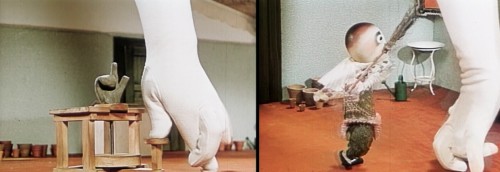 23
23
The hand bursts out and impatiently demands a statue of himself.
The potter pulls out a broom.
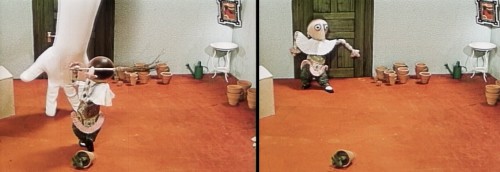 24
24
He uses the broom to push the hand out the door.
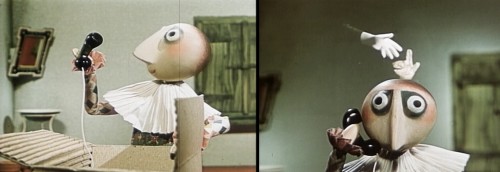 25
25
A phone rings in the crardboard box, and the potter answers it.
The phone demands the statue . . .
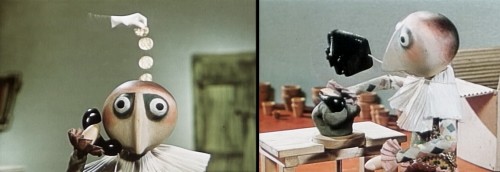 26
26
. . . and offers lots of money.
The potter throws the phone away.
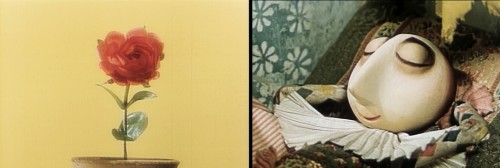 28
28
He dreams of flowers until he’s awakened.
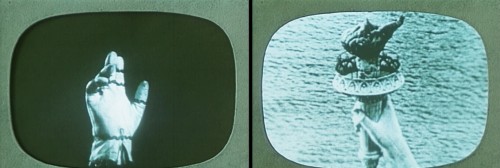 31
31
We see many examples of great hands in history.
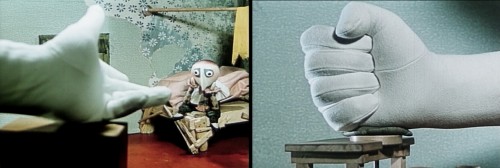 33
33
Again the hand implores and then demands the statue.
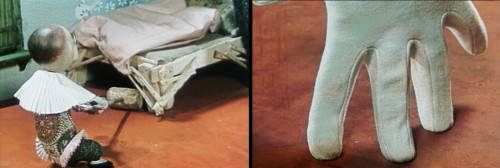 34
34
The sculptor drags a heavy mallet out from under the bed.
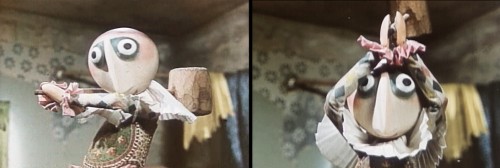 35
35
He swings it at the hand to get rid of him.
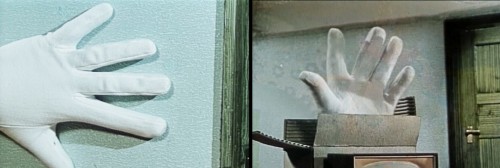 36
36
The hand goes into the box.
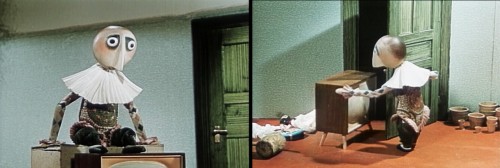 37
37
The sculptor pushes the box and the tv out the door.
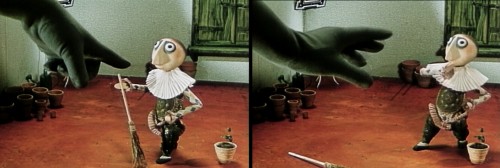 39
39
In no time the hand is back . . . demanding.
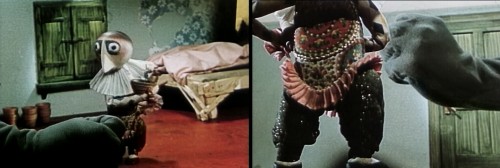 40
40
The sculptor stands resistant.
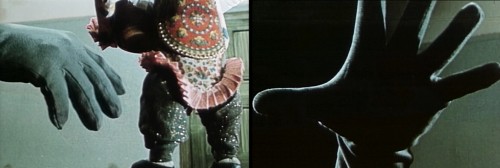 41
41
He’s pushed back into a corner.
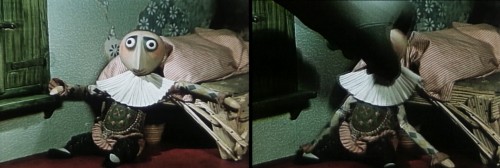 42
42
The hand grabs him by the head.
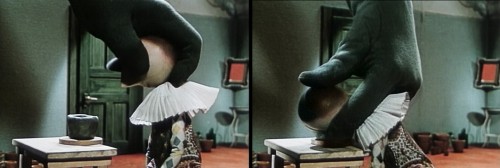 43
43
And he is dragged to the potter’s wheel.
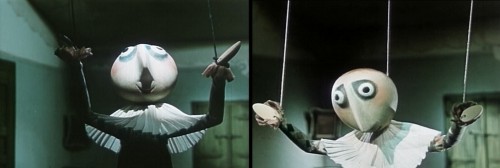 45
45
He makes a marionette of the potter.
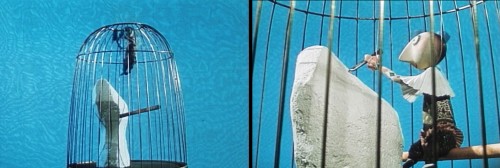 46
46
The potter’s encaged and forced to sculpt the statue.
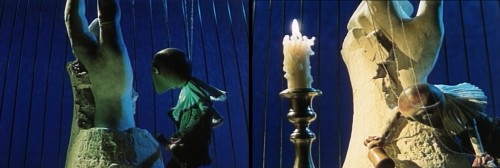 48
48
He’s forced to work endless days and nights sculpting.
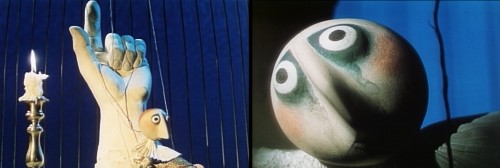 49
49
Until, finally, the statue is completed.
 50
50
The sculptor uses the statue to crash through the bars of the cage.
 51
51
He jumps free of the bondage of the “State.”
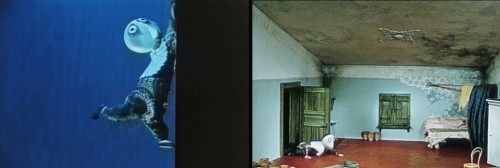 52
52
Eventually, damaged, he makes his way back home.
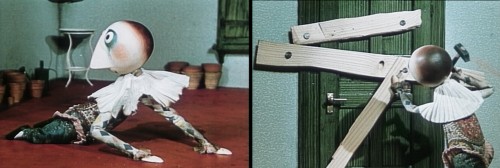 53
53
He boards up the door and window.
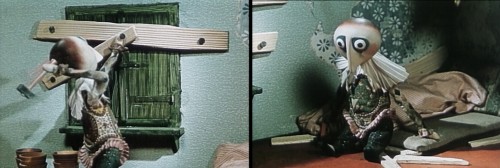 54
54
He cares for the hurt plant.
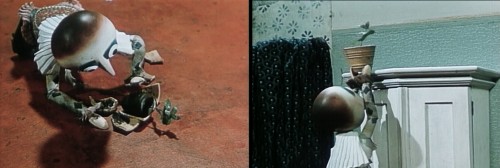 55
55
And places it in a secure spot out of reach.
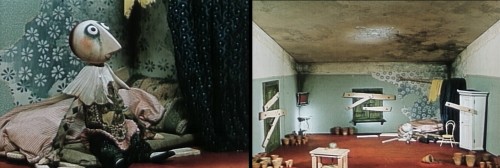 56
56
The sculptor is haunted by the sound of the hand.
He dies.
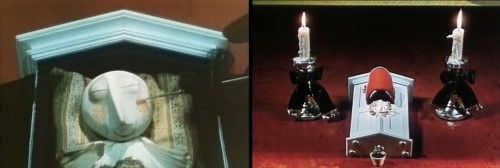 57
57
The hand enters, places him in a casket he makes of the cabinet.
(Thus destroying the plant.)
Animation &Animation Artifacts &Independent Animation 02 Jan 2011 09:54 am
Culhane Ajax recap
This post, with some slight variation, originally appeared on May 16, 2006. I was thumbing through one of Shamus Culhane’s books and decided to post it anew.
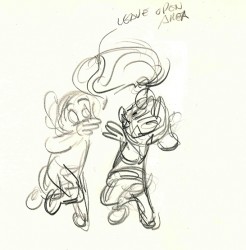 - Acting as a companion piece to Mark Mayerson‘s posts re Shamus Culhane‘s direction on The Pied Piper of Basin Street for Lantz in 1944, I am posting these drawings from the early spots Culhane directed for Ajax Cleanser.
- Acting as a companion piece to Mark Mayerson‘s posts re Shamus Culhane‘s direction on The Pied Piper of Basin Street for Lantz in 1944, I am posting these drawings from the early spots Culhane directed for Ajax Cleanser.
As Culhane reports in his autobiography, the call came out of the blue in 1949 from an advertising agency offering these commercials which became enormously popular. Culhane formed a studio hiring Art Heinemann to design the three elves in the spot, and Art Babbitt teamed with Shamus to animate it. The ad campaign lasted until the late 1950′s. I can remember the spots clearly, though I was never overwhelmed by them, even as a child.
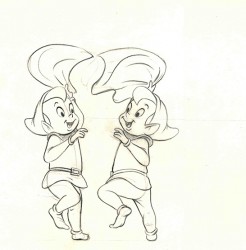 It’s interesting to see how varied the rough and the clean–up are from each other (they both are for the same number.) The clean-up is also obviously designed to be inked not xeroxed (which predates 1959).
It’s interesting to see how varied the rough and the clean–up are from each other (they both are for the same number.) The clean-up is also obviously designed to be inked not xeroxed (which predates 1959).
I bought these drawings which while marked as animation drawings by Culhane, are probably not. The rough could possibly be his work, but I don’t think so.
It looks more like Emery Hawkins, but that’s not much more than a guess. The clean up looks like the work of Gerry Dvorak, but that’s also an educated guess. If anyone out there has a better idea, let me know.
I’m also sure that this spot ran in the mid 1950′s. I distinctly remember seeing it originally on tv when I was a child. To see one of the Ajax commercials go here to see a number of early tv spots.
If you click on either image you’ll enlarge it to full animation paper size.
